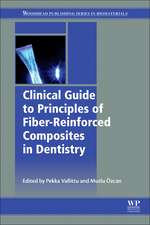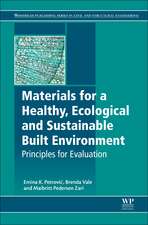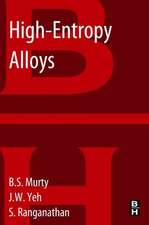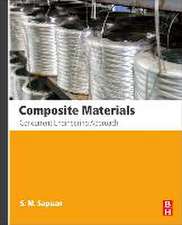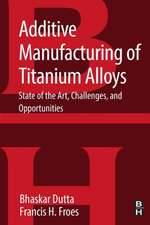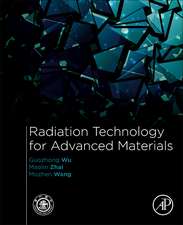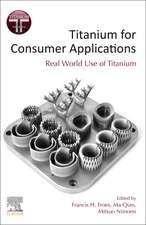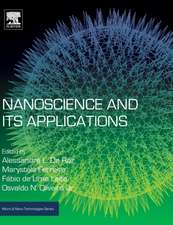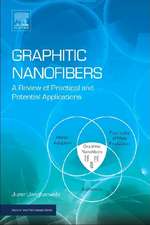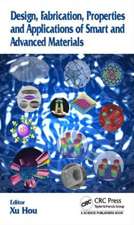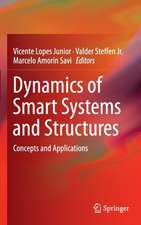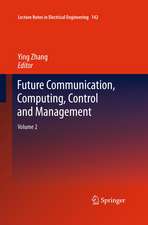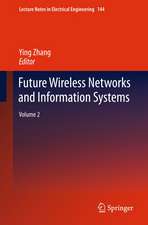Extractive Metallurgy of Titanium: Conventional and Recent Advances in Extraction and Production of Titanium Metal
Editat de Zhigang Zak Fang, Francis Froes, Ying Zhangen Limba Engleză Paperback – 7 noi 2019
Sections cover the purity of titanium metal produced based on ASTM and other industry standards, energy consumption, cost and the potential environmental impacts of the processes.
- Provides information on new and developing low cost, high integrity methods for titanium metal production
- Discusses new markets for titanium due to the decreased cost of newly developed processes
- Covers specific information on new methods, including the chemical and physical characteristics produced
Preț: 912.21 lei
Preț vechi: 1180.38 lei
-23% Nou
Puncte Express: 1368
Preț estimativ în valută:
174.57€ • 181.58$ • 144.12£
174.57€ • 181.58$ • 144.12£
Carte tipărită la comandă
Livrare economică 07-21 aprilie
Preluare comenzi: 021 569.72.76
Specificații
ISBN-13: 9780128172001
ISBN-10: 0128172002
Pagini: 436
Ilustrații: 240 illustrations (40 in full color)
Dimensiuni: 152 x 229 x 29 mm
Greutate: 0.58 kg
Editura: ELSEVIER SCIENCE
ISBN-10: 0128172002
Pagini: 436
Ilustrații: 240 illustrations (40 in full color)
Dimensiuni: 152 x 229 x 29 mm
Greutate: 0.58 kg
Editura: ELSEVIER SCIENCE
Public țintă
Researchers from universities, institutes, and companies in the fields of materials and manufacturing; undergraduate and higher degree research studentsCuprins
Contents
Contributors xi
1. Introduction to the development of processes for primary
Ti metal production 1
Zhigang Zak Fang, Hyrum D. Lefler, F.H. Froes, and Ying Zhang
References 8
Part 1 Extractive chemical metallurgy processes 11
2. A brief introduction to production of titanium dioxide
and titanium tetrachloride 13
Michael L. Free
1. Background 13
2. Ore sources 13
3. Processing methods 14
References 17
3. Minerals, slags, and other feedstock for the production
of titanium metal 19
Dimitrios Filippou and Guillaume Hudon
1. Introduction 19
2. Ilmenite, rutile, and other natural titanium minerals 21
3. Ilmenite smelting to titania slag 26
4. Ilmenite conversion to synthetic rutile 32
5. Titania slag upgrading to UGS 36
6. Production of titanium carbide feedstock 37
7. Conclusions 38
Acknowledgments 41
References 41
4. Chemical processes for the production of titanium tetrachloride
as precursor of titanium metal 47
Guillaume Hudon and Dimitrios Filippou
1. Introduction 47
2. Titanium tetrachloride 47
3. Production of titanium tetrachloride 49
4. Titanium tetrachloride purification 55
5. Production of pure titanium dioxide 56
6. Other precursors 59
Acknowledgments 60
References 60
Part 2 Thermochemical reduction of TiCl4 63
5. Fundamentals of thermochemical reduction of TiCl4 65
Toru H. Okabe and Osamu Takeda
1. Historical developments in titanium metal production 65
2. Kroll process 66
3. Hunter process 71
4. Fundamentals of titanium reduction process 75
5. Electrochemical reactions during thermochemical reduction 78
6. Reduction mechanism of TiCl4 during the Kroll process 81
7. Past research for new titanium production processes 83
8. Summary 90
References 92
6. The Kroll process and production of titanium sponge 97
Matthew R. Earlam
1. Introduction 97
2. Source of ore 99
3. Production of TiCl4 100
4. Purification of TiCl4 101
5. The Hunter process 102
6. Armstrong process 103
7. Kroll process 103
8. Magnesium reduced acid leach (MRAL) (no longer practiced) 104
9. Vacuum distillation process TOHO timet 107
10. Preparation for melting 110
References 111
7. A modified Kroll process via production of TiH2 - thermochemical
reductions of TiCl4 using hydrogen and Mg 113
Mykhailo Matviychuk, Andrey Klevtsov, and Vladimir S. Moxson
1. Introduction 113
2. Process description 114
3. Experimental results 120
4. Role of hydrogen for ADMA process 122
References 127
Further reading 128
Part 3 Thermochemical reduction of TiO2 129
8. Metallothermic reduction of TiO2 131
Toru H. Okabe
1. Introduction 131
2. Studies on reduction of titanium oxide before 2000 134
3. Studies on reduction of titanium oxide after 2000 143
4. Future prospects of metallothermic reduction processes for direct
production of titanium from oxides 155
5. Summary 159
References 160
9. Hydrogen assisted magnesiothermic reduction (HAMR) of
TiO2 to produce titanium metal powder 165
Yang Xia, Hyrum D. Lefler, Ying Zhang, Pei Sun, and Zhigang Zak Fang
1. Introduction 165
2. Fundamentals of the HAMR process 167
3. HAMR process description 172
4. HAMR product characterization 173
5. Summary 176
Acknowledgments 176
References 177
10. Deoxygenation of Ti metal 181
Ying Zhang, Zhigang Zak Fang, Pei Sun, Yang Xia, Hyrum D. Lefler,
and Shili Zheng
1. Introduction 181
2. Thermodynamic properties of the TieO solid solutions 182
3. Methods of deoxygenation 186
4. Concluding remarks 206
A. Appendix 207
Acknowledgments 220
References 220
Part 4 Electrochemical reduction of TiO2 and TiOC 225
11. Invention and fundamentals of the FFC Cambridge Process 227
George Z. Chen and Derek J. Fray
1. Background: how the concept of electro-deoxidation came about 227
2. Understanding of electro-deoxidation: interactions of the oxide cathode
with molten salts 230
3. Understanding of electro-deoxidation: metal/insulator/electrolyte 3PI
models 235
4. Understanding of electro-deoxidation: the metal-to-oxide molar volume
ratio 236
5. Development of an inert anode for electro-deoxidation in calcium
chloride based melts 241
6. Electro-deoxidation of other metal oxides 246
7. Electro-desulfidation of metal sulfides 257
8. Electro-deoxidation of mixed metal oxides 261
9. Titanium based medical implant materials 273
10. Cathodic protection of titanium 276
11. Outlook and Prospective 278
12. Conclusions 279
References 280
12. OS process: calciothermic reduction of TiO2 via CaO electrolysis
in molten CaCl2 287
Ryosuke O. Suzuki, Shungo Natsui, and Tatsuya Kikuchi
1. Introduction 287
2. Cell design 296
3. Thermodynamics of desired salt 298
4. Validity of Ca reduction during electrolysis 303
5. Conclusion 308
References 309
13. Titanium production through electrolysis of titanium oxycarbide
consumable anodedthe USTB process 315
Hongmin Zhu, Shuqiang Jiao, Jiusan Xiao, and Jun Zhu
1. Introduction 315
2. Crystalline structure of titanium oxycarbide and titanium
oxycarbonitride 316
3. Thermodynamic properties and preparation of titanium oxycarbide from
TiO2 by carbon thermal reduction 317
4. Electrochemical dissolution of consumable anode 320
5. Electrochemical deposition on the cathode 325
6. Scaling up and practices of USTB process 326
References 328
14. Electrolysis of carbothermic treated titanium oxides to produce
Ti metal 331
James C. Withers
References 343
Further reading 347
Part 5 Other processes 349
15. Selected processes for Ti production e a cursory review 351
Pei Sun, Ying Zhang, and Zhigang Zak Fang
1. Introduction 351
2. Continuous processes using Mg or Na as the reductant 352
3. Processes using low-cost alternatives as reductants 356
4. Summary 360
Acknowledgments 360
References 360
16. Recycling of Ti 363
Osamu Takeda, Toru H. Okabe
1. Introduction 363
2. Ti scraps generated in the smelting process 364
3. Ti scraps generated in the aircraft industry 367
4. Material flow of Ti scraps 373
5. Recycling technologies for Ti scraps 374
6. Future perspective of recycling technologies 377
7. Conclusions and future remarks 382
Acknowledgments 383
References 383
17. Energy consumption of the Kroll and HAMR processes for
titanium production 389
Yang Xia, Hyrum D. Lefler, Zhigang Zak Fang, Ying Zhang, and Pei Sun
1. Introduction 389
2. Review of energy consumption in the Kroll process 390
3. Modeling and analysis of energy consumption in the HAMR process 398
4. Energy consumption in other emerging processes 404
5. Summary and comparison of Kroll and HAMR processes 405
Acknowledgments 406
References 407
Index 411
Contributors xi
1. Introduction to the development of processes for primary
Ti metal production 1
Zhigang Zak Fang, Hyrum D. Lefler, F.H. Froes, and Ying Zhang
References 8
Part 1 Extractive chemical metallurgy processes 11
2. A brief introduction to production of titanium dioxide
and titanium tetrachloride 13
Michael L. Free
1. Background 13
2. Ore sources 13
3. Processing methods 14
References 17
3. Minerals, slags, and other feedstock for the production
of titanium metal 19
Dimitrios Filippou and Guillaume Hudon
1. Introduction 19
2. Ilmenite, rutile, and other natural titanium minerals 21
3. Ilmenite smelting to titania slag 26
4. Ilmenite conversion to synthetic rutile 32
5. Titania slag upgrading to UGS 36
6. Production of titanium carbide feedstock 37
7. Conclusions 38
Acknowledgments 41
References 41
4. Chemical processes for the production of titanium tetrachloride
as precursor of titanium metal 47
Guillaume Hudon and Dimitrios Filippou
1. Introduction 47
2. Titanium tetrachloride 47
3. Production of titanium tetrachloride 49
4. Titanium tetrachloride purification 55
5. Production of pure titanium dioxide 56
6. Other precursors 59
Acknowledgments 60
References 60
Part 2 Thermochemical reduction of TiCl4 63
5. Fundamentals of thermochemical reduction of TiCl4 65
Toru H. Okabe and Osamu Takeda
1. Historical developments in titanium metal production 65
2. Kroll process 66
3. Hunter process 71
4. Fundamentals of titanium reduction process 75
5. Electrochemical reactions during thermochemical reduction 78
6. Reduction mechanism of TiCl4 during the Kroll process 81
7. Past research for new titanium production processes 83
8. Summary 90
References 92
6. The Kroll process and production of titanium sponge 97
Matthew R. Earlam
1. Introduction 97
2. Source of ore 99
3. Production of TiCl4 100
4. Purification of TiCl4 101
5. The Hunter process 102
6. Armstrong process 103
7. Kroll process 103
8. Magnesium reduced acid leach (MRAL) (no longer practiced) 104
9. Vacuum distillation process TOHO timet 107
10. Preparation for melting 110
References 111
7. A modified Kroll process via production of TiH2 - thermochemical
reductions of TiCl4 using hydrogen and Mg 113
Mykhailo Matviychuk, Andrey Klevtsov, and Vladimir S. Moxson
1. Introduction 113
2. Process description 114
3. Experimental results 120
4. Role of hydrogen for ADMA process 122
References 127
Further reading 128
Part 3 Thermochemical reduction of TiO2 129
8. Metallothermic reduction of TiO2 131
Toru H. Okabe
1. Introduction 131
2. Studies on reduction of titanium oxide before 2000 134
3. Studies on reduction of titanium oxide after 2000 143
4. Future prospects of metallothermic reduction processes for direct
production of titanium from oxides 155
5. Summary 159
References 160
9. Hydrogen assisted magnesiothermic reduction (HAMR) of
TiO2 to produce titanium metal powder 165
Yang Xia, Hyrum D. Lefler, Ying Zhang, Pei Sun, and Zhigang Zak Fang
1. Introduction 165
2. Fundamentals of the HAMR process 167
3. HAMR process description 172
4. HAMR product characterization 173
5. Summary 176
Acknowledgments 176
References 177
10. Deoxygenation of Ti metal 181
Ying Zhang, Zhigang Zak Fang, Pei Sun, Yang Xia, Hyrum D. Lefler,
and Shili Zheng
1. Introduction 181
2. Thermodynamic properties of the TieO solid solutions 182
3. Methods of deoxygenation 186
4. Concluding remarks 206
A. Appendix 207
Acknowledgments 220
References 220
Part 4 Electrochemical reduction of TiO2 and TiOC 225
11. Invention and fundamentals of the FFC Cambridge Process 227
George Z. Chen and Derek J. Fray
1. Background: how the concept of electro-deoxidation came about 227
2. Understanding of electro-deoxidation: interactions of the oxide cathode
with molten salts 230
3. Understanding of electro-deoxidation: metal/insulator/electrolyte 3PI
models 235
4. Understanding of electro-deoxidation: the metal-to-oxide molar volume
ratio 236
5. Development of an inert anode for electro-deoxidation in calcium
chloride based melts 241
6. Electro-deoxidation of other metal oxides 246
7. Electro-desulfidation of metal sulfides 257
8. Electro-deoxidation of mixed metal oxides 261
9. Titanium based medical implant materials 273
10. Cathodic protection of titanium 276
11. Outlook and Prospective 278
12. Conclusions 279
References 280
12. OS process: calciothermic reduction of TiO2 via CaO electrolysis
in molten CaCl2 287
Ryosuke O. Suzuki, Shungo Natsui, and Tatsuya Kikuchi
1. Introduction 287
2. Cell design 296
3. Thermodynamics of desired salt 298
4. Validity of Ca reduction during electrolysis 303
5. Conclusion 308
References 309
13. Titanium production through electrolysis of titanium oxycarbide
consumable anodedthe USTB process 315
Hongmin Zhu, Shuqiang Jiao, Jiusan Xiao, and Jun Zhu
1. Introduction 315
2. Crystalline structure of titanium oxycarbide and titanium
oxycarbonitride 316
3. Thermodynamic properties and preparation of titanium oxycarbide from
TiO2 by carbon thermal reduction 317
4. Electrochemical dissolution of consumable anode 320
5. Electrochemical deposition on the cathode 325
6. Scaling up and practices of USTB process 326
References 328
14. Electrolysis of carbothermic treated titanium oxides to produce
Ti metal 331
James C. Withers
References 343
Further reading 347
Part 5 Other processes 349
15. Selected processes for Ti production e a cursory review 351
Pei Sun, Ying Zhang, and Zhigang Zak Fang
1. Introduction 351
2. Continuous processes using Mg or Na as the reductant 352
3. Processes using low-cost alternatives as reductants 356
4. Summary 360
Acknowledgments 360
References 360
16. Recycling of Ti 363
Osamu Takeda, Toru H. Okabe
1. Introduction 363
2. Ti scraps generated in the smelting process 364
3. Ti scraps generated in the aircraft industry 367
4. Material flow of Ti scraps 373
5. Recycling technologies for Ti scraps 374
6. Future perspective of recycling technologies 377
7. Conclusions and future remarks 382
Acknowledgments 383
References 383
17. Energy consumption of the Kroll and HAMR processes for
titanium production 389
Yang Xia, Hyrum D. Lefler, Zhigang Zak Fang, Ying Zhang, and Pei Sun
1. Introduction 389
2. Review of energy consumption in the Kroll process 390
3. Modeling and analysis of energy consumption in the HAMR process 398
4. Energy consumption in other emerging processes 404
5. Summary and comparison of Kroll and HAMR processes 405
Acknowledgments 406
References 407
Index 411

